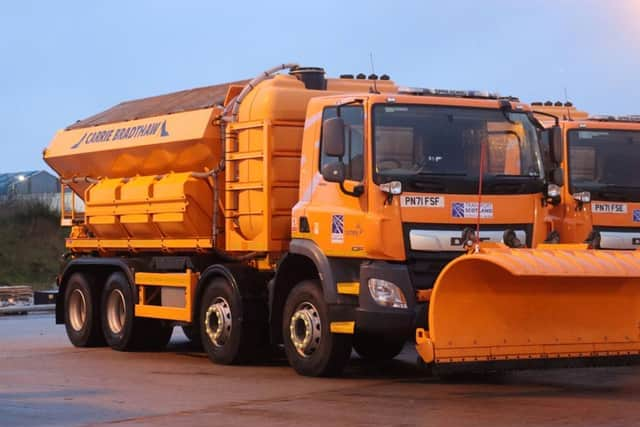How does Glasgow City Council choose which roads to grit? How to check when and where your road will be de-iced
and live on Freeview channel 276
Glasgow City Council’s gritters operate under ‘The Winter Maintenance Plan’ which was revised during the summer of 2022 to incorporate operational and management improvements. There is detailed information available for operational personnel in the Neighbourhoods, Regeneration and Sustainability (NRS) Good Practice Guide to Winter Maintenance.
How do the council decide when to grit?
The day-to-day routine operational decisions of the gritters is decided by the ‘Decision Maker’ using specialist road weather forecasts alongside road and weather monitoring data.
Advertisement
Hide AdAdvertisement
Hide AdOn receipt of a Specialist Road Weather Forecast the decision maker will reach a decision for the next 24 hours which will be verified by one of the other Decision Makers - then one of three treatment options will be carried out:
- Action - ice / snow on the road - confirmation of start time, spread rate, and routes.
- No action - no ice / snow - minimum road surface temperature forecast at or above 0˚C.
- Patrol - no ice / snow - road surface temperature forecast below 0C with no ice/hoar frost or freezing conditions present.
The Action for Weather will confirm the precautionary and post treatment spread rate and the routes to be treated/cleared of snow. The Action for Weather will be circulated as required.
How do the council choose which roads to grit?
Carriageways,footways, and cycling lanes are all gritted on a scaling system from priority one through to priority three - priority one being the highest.
The routes are reviewed on an annual basis taking into account any alterations to the roads - which are treated under the specified gritting criteria.
Advertisement
Hide AdAdvertisement
Hide AdPost-treatment of priority two footways and carriageways takes a back-seat to priority one footways and carriageways - priority three footways and carriageways are treated when there is expected to be ice or snow for a period of longer than two days.


Priority one roadways include:
- All main bus routes registered at the end of the summer in any year within the city The length of public road from the adjacent Priority 1 Carriageway Route to any designated school dropping-off points on the public road for Assisted Support Learning buses and emergency vehicles
- The public road access to fire, ambulance and police stations and main bus garages from the adjacent Priority 1 Carriageway
- Public access roads to Park and Ride car parks from the adjacent Priority 1 Carriageway Route
- Buchanan Street bus station
- A or B class roads
- Hills steeper than 1 in 10 gradients
- Industrial areas as appropriate
- The priority one routes for footways are as follows:
- Access routes to schools during term time
- Pedestrian precincts
- Prioritised city centre footways with high pedestrian traffic
- Shopping centres out with the city centre
- Hills steeper than 1 in 10 with moderate pedestrian traffic
There are far, far less priority one cycle lanes (cycle lanes on carriageways are gritted at the same time as the road) - the priority one cycle routes are as follows:
- The operational length of the segregated Cycle Way network
- The National Cycle Network Number 75 (NCN 75) that extends from Cambuslang Bridge/boundary with South Lanarkshire Council in the east to Riverside Museum in the west
Priority two Carriageways include the following:
- Health Centres
- Day Care Centres
- Community Sports Centres
- Libraries
- Places of worship and any other places of local significance
- Appropriate link routes to main Priority 1 Carriageways within each neighbourhood
- Industrial access roads not pre-treated
Priority two footways include the following:
- Local Shopping
- Health Centres
- Daycare Centres
- Community Sports Centres
- Libraries
- Places of worship and any other places of local significance
- Appropriate link routes to main Priority 1 Footways within each neighbourhood
- A designated access route through city parks
Priority three footways and carriageways are all remaining footways and carriageways not mentioned in any of the above lists.
How long should it take for the council to grit the roads?
Gritting should begin on all priority one footways, cycle lanes, and carriageways within five hours of the instructed start time.
Advertisement
Hide AdAdvertisement
Hide AdReactive or non-planned treatment of all priority roads, cycle lanes, and foot paths will only take place between 7:30am and 6:30pm.
Where can I check the gritters routes?
You can check the grit routes online via the Glasgow City Council website.
The map also shows the location of the 1,580 grit bins across Glasgow - as well as supplementary one tonne grit sacks placed strategically throughout the city during severe conditions.
Comment Guidelines
National World encourages reader discussion on our stories. User feedback, insights and back-and-forth exchanges add a rich layer of context to reporting. Please review our Community Guidelines before commenting.
